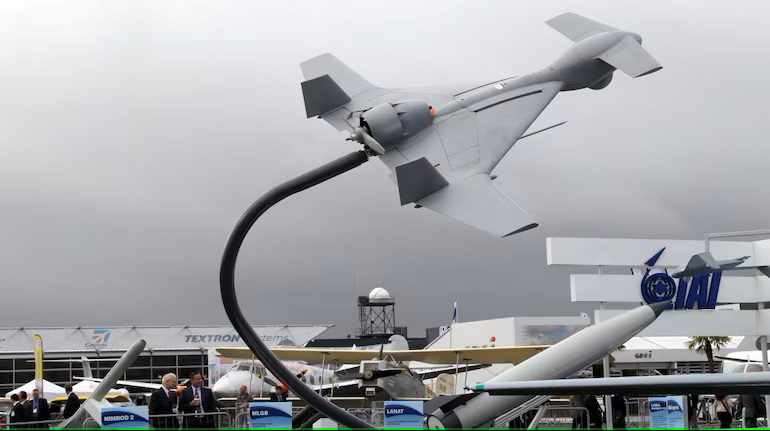After the recent Pahalgam attack, India carried out ‘Operation Sindoor’, targeting and assailing nine terrorists' infrastructures in Pakistan and the PoK areas.
India is employing advanced military equipment such as Dassault’s Rafale, SCALP and HAMMER missiles, the S-400 advanced missile system, and the HAROP Drone.
On Thursday, India used HAROP drones to target multiple locations, including the two largest cities, Karachi and Lahore.
Pakistan military spokesperson Ahmed Sharif Chaudhry commented, "Indian drones continue to be sent into Pakistan airspace...(India) will continue to pay dearly for this naked aggression." However, India hasn’t commented on it yet.
Check Out| Indian Airports Temporarily Closed Until May 10th, Check Complete List Here, after Operation Sindoor
What are HARPY/HAROP Drones? Check Speed, Range, Cost & Features

Source: Moneycontrol
HAROP or HARPY drones are loitering munitions (suicide drones) developed by Israel Aerospace Industries (IAI), designed for both naval and land operations.
HARPY targets radar systems autonomously, while HAROP offers both autonomous and operator-controlled modes, with enhanced sensors for broader target sets, including moving and static targets.
| Feature | HARPY | HAROP |
| Role | Anti-radar, autonomous | Multi-mission, man-in-the-loop or autonomous |
| Speed | 185–190 km/h | Up to 400 km/h |
| Range | 500–1,000 km | 1,000 km |
| Endurance | 4–6 hours | 6–9 hours |
| Warhead | 32 kg | 23 kg |
| Weight | 135 kg | 135 kg |
| Sensors | Anti-radar | EO/IR/FLIR, anti-radar |
| Guidance | Autonomous | Autonomous + remote operator |
Cost
The HAROP is more expensive than HARPY, estimated at about $700,000, due to its advanced sensors and dual operational modes.
Features
- Loitering Munition: Combines surveillance and strike roles, acting as both a reconnaissance drone and a precision-guided missile.
- Endurance & Range: Can loiter over target zones for up to 9 hours with an operational range of up to 1,000 km, enabling deep standoff attacks without exposing operators.
- Payload: Carries a 23 kg high-explosive warhead for neutralising high-value targets like radars, missile systems, vehicles, and command centres.
- Sensors: Equipped with electro-optical (EO), infrared (IR), FLIR sensors, and a colour CCD camera for comprehensive target detection and identification.
- Guidance & Control: Operates autonomously or under human supervision (man-in-the-loop), allowing operators to abort or redirect attacks in real time.
- Launch Platform: Canister-launched from land vehicles, naval platforms, or configured for air-launch, making it highly deployable.
- GNSS Jamming Immunity: Resistant to satellite navigation jamming, ensuring reliable operation in contested environments.
- Multi-Mission Flexibility: Suitable for land and naval operations, urban warfare, counter-terror missions, and both high- and low-intensity conflicts.
- Attack Profile: Capable of striking from multiple angles and returning to base if a target is not engaged, minimising collateral damage.
Explore| List of Wars Between India and Pakistan
What are the Key Differences Between Harop and Harpy Drones?
Many of you must be confused between HAROP and HARPY drones, so here we are clearing the confusion from your mind.
HAROP is a variant of the HARPY drone, which has evolved (become a better version) from its previous version (HARPY). Here are the key differences between the Harop and Harpy drone systems:
i) Guidance and Targeting
- HARPY: Fully autonomous, “fire-and-forget” anti-radiation drone that homes in on enemy radar emissions using an RF seeker. Cannot be controlled after launch and only attacks emitting radar targets.
- HAROP: Features both autonomous and operator-controlled (man-in-the-loop) modes. Uses advanced electro-optical/infrared (EO/IR/FLIR) sensors, enabling real-time target identification and attack on a broader range of targets, including moving and static ones. Attack can be aborted or redirected by the operator.
ii) Sensors
- HARPY: Radio Frequency (RF) seeker only targets radar emitters.
- HAROP: EO/IR/FLIR sensors plus anti-radar capability can engage a wide variety of targets, not just radars.
iii) Mission Flexibility
- HARPY: Specialised for Suppression/Destruction of Enemy Air Defences (SEAD/DEAD), targeting only active radars.
- HAROP: Multi-mission can strike radars, vehicles, infrastructure, and personnel and is suitable for urban and naval operations.
iv) Control and Abortion
- HARPY: No post-launch control; the attack is aborted if the radar stops emitting.
- HAROP: The Operator can abort or redirect the attack mid-flight, reducing collateral damage and allowing retargeting.
v) Endurance and Range
- HARPY: Shorter range and loiter time compared to HAROP (varies by model, but typically less than HAROP).
- HAROP: Longer range (up to 1,000 km) and endurance (up to 9 hours), with improved operational flexibility.
vi) Warhead
- HARPY: Typically a heavier warhead (~32 kg).
- HAROP: Slightly lighter warhead (~23 kg), optimised for precision strikes.
In a Nutshell
| Feature | HARPY | HAROP |
| Guidance | Autonomous, RF seeker | EO/IR sensors, man-in-the-loop or autonomous |
| Target Set | Radar emitters only | Radars, vehicles, infrastructure, personnel |
| Control | No post-launch control | The Operator can control/abort |
| Sensors | RF only | EO/IR/FLIR + anti-radar |
| Endurance | Shorter | Up to 9 hours |
| Range | Shorter | Up to 1,000 km |
| Warhead | 32 kg | 23 kg |
What's Next| Who is Lt. Colonel Sophia Qureshi? Check Education Qualification, Career Details, Awards and Honours
Comments
All Comments (0)
Join the conversation